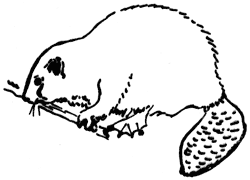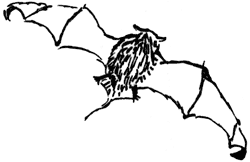|
Volume XIII No. 1 - October, 1947
Renewal Of Beaver Activity In Copeland Creek
By W. S. Vincent, Ranger-Naturalist
Early this season the crew clearing out the Caste Creek Firetrail
observed that beaver were damming the culvert at Copeland Creek. Other
park employees reported additional signs of renewed activity to the
naturalist's office. On July 2 and July 16 I visited the area with
Ranger-Naturalist O. L. Wallis.

Beaver had been very active in the Copeland Creek region for several
years after 1931, when they first appeared in this section of the park.
They soon exhausted the willows, their principal food here, and were
forced to migrate to a more favorable habitat.
On July 16, it was noted that the willows have recovered. With their
food supply replenished, the beavers have renewed activity along this
stream. Nearly every one of the old dam sites had been or was in the
process of being repaired. A considerable amount of water is being
stored behind these dams in the area which extends about 250 yards below
the firetrail. The restored dams range from five to fifty feet in width
and from one to four feet in height. Behind one dam, the impounded water
is backed up approximately one hundred feet. The total number of dams is
about 15.
As my attention was drawn by a sudden disturbance on the bottom of
one of the pools I saw a beaver departing from the immediate vicinity. A
full view of the animal was obtained as it climbed over the dam and
disappeared into the willows below the site. The beaver appeared to be
full grown and in good condition.
From the amount of activity in the area, it is estimated that only
one pair of beaver are working along the stream. The cuttings are
somewhat scattered throughout the entire area with occasional cut
branchlets submerged in open areas apparently used as food depots. No
indication of lodge-building was noted.
In the 1946 issue of Nature Notes, Ranger-Naturalist Wallis reported
no sign of fresh beaver activity in the Copeland Creek area, but some
fresh workings along lower Annie Creek. Observations this year indicates
that no new activity has taken place along Annie Creek.
Other indications of beaver activity in the park have been seen only
in lower Bybee Creek, where a considerable number of fresh cuttings were
observed and one quite large dam had been constructed. This particular
dam was novel in that it was constructed in very fast water, and was
five feet high and twenty feet across, backing up a pool forty feet
long. Freshly peeled twigs of willow were noted in the dam but no other
sign of the beaver was noted.
Deer Observations
By O. L. Wallis, Ranger-Naturalist
Although three species of deer are reported from the park area, the
occasion is noteworthy that specimens of each form are seen within the
course of one day's travel within the park. On July 27, while driving
down the Wineglass motorway with Ranger-Naturalist Don Findlay, I
observed and Idaho whitetail doe, Odocoileus virginianus
ochrourus Bailey, cross the road and dash off into the timber with
its "flag" highly raised.
Later in the morning three Rocky Mountain mule deer bucks
Odocoileus hemionus hemionus (Rafinesque), were seen by the
roadway near Bear Creek. Their white rump patches and black-tipped
creamy tails showed distinctly against the dark background of the
lodgepole timberland. This sector of the park is typical of the
preferred arid habitat of this species.
On the way back to the Park Headquarters, three Columbia blacktail
deer, Odocoileus hemionus columbianus (Richardson), were feeding
in the meadow between Kerr Notch and Lost Creek Ranger Station.
Members of the guided trip afield had opportunity to observe a mule
deer buck near the summit of Garfield Peak on August 4. This buck had
one of its antlers broken and the other was still in the velvet. The
tail, although typically cylindrical in shape and creamy in color, had a
black strip extending down its entire length; the white rump patch was
greatly reduced. These characteristics would seem to indicate that this
individual was an intergrade with the Columbia blacktail deer.
While conducting a stream survey on upper Bybee Creek, I observed a
large six point whitetail buck along the stream, one mile below
Lightning Spring.
Blacktail were seen on various occasions along the streams and the
highway in the western portions of the park through the summer. These,
the most abundant of park deer, appear to be present in their usual
numbers. There was a good fawn crop, so numerous fawns were to be seen
during the season.
Bat Recorded From Wizard Island
By O. L. Wallis, Ranger-Naturalist

A small bat was observed dipping down to take a drink from the
waters of Emerald Pool on the west side of Wizard Island at midday on
August 23. Later it was seen zigzagging after flying insects. On August
17, this bat presumably was also observed in the early afternoon resting
on one of the angular pieces of lava in the bright sunlight.
Later the specimen was collected for identification. It was a small
bat with brownish body and black wings, and probably belongs to the
genus Myotis although positive identification will be made by a
specialist in the near future.
This is the first known record of a bat on Wizard Island and
increases the number of reported species occurring on the island.
Conies, golden mantled ground squirrels, deer mice, and mazama
red-backed mice were collected by Ranger-Naturalist R. R. Huestis in
1937. The Klamath or Allen's chipmunk was listed prior to this date.
| 
